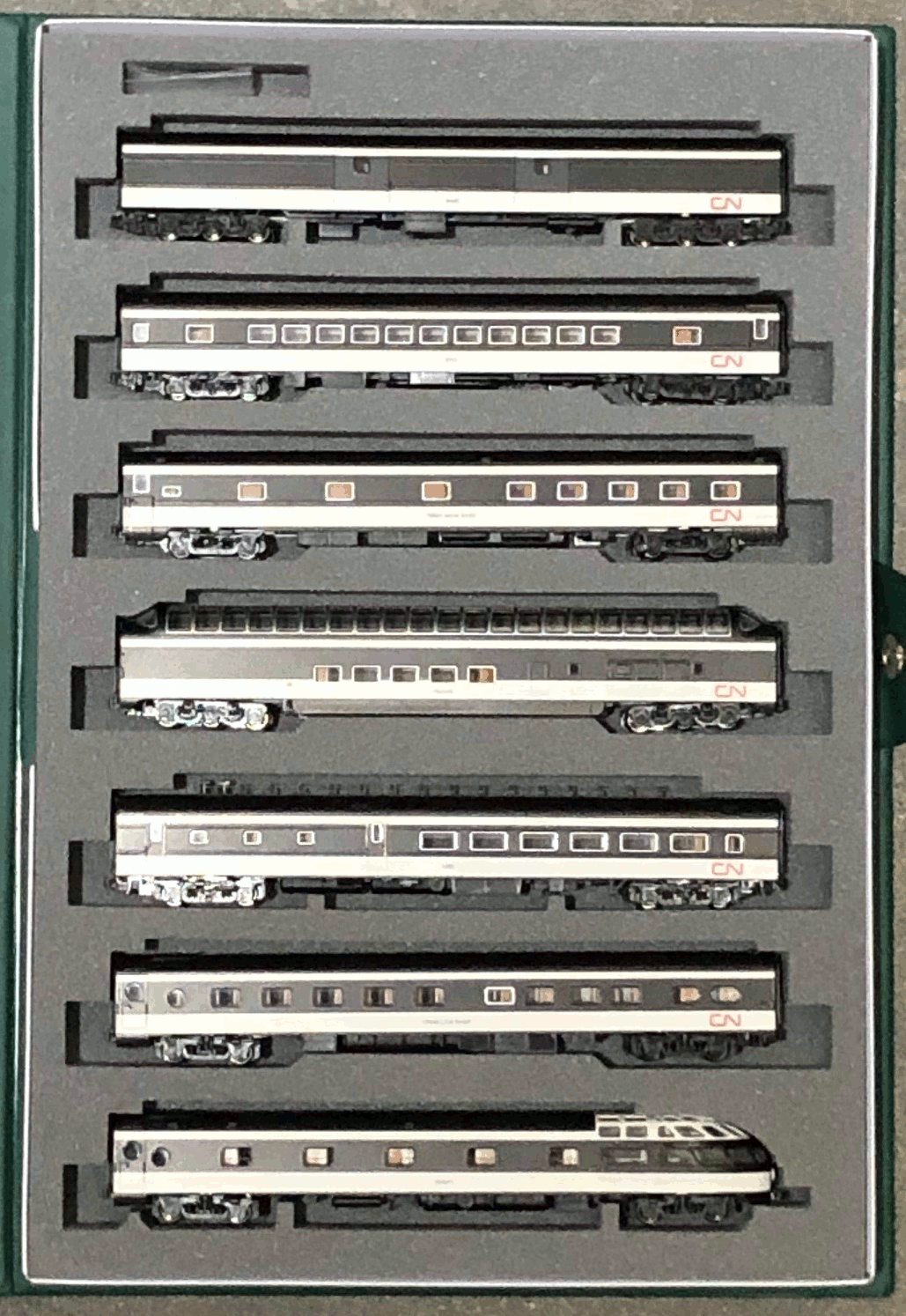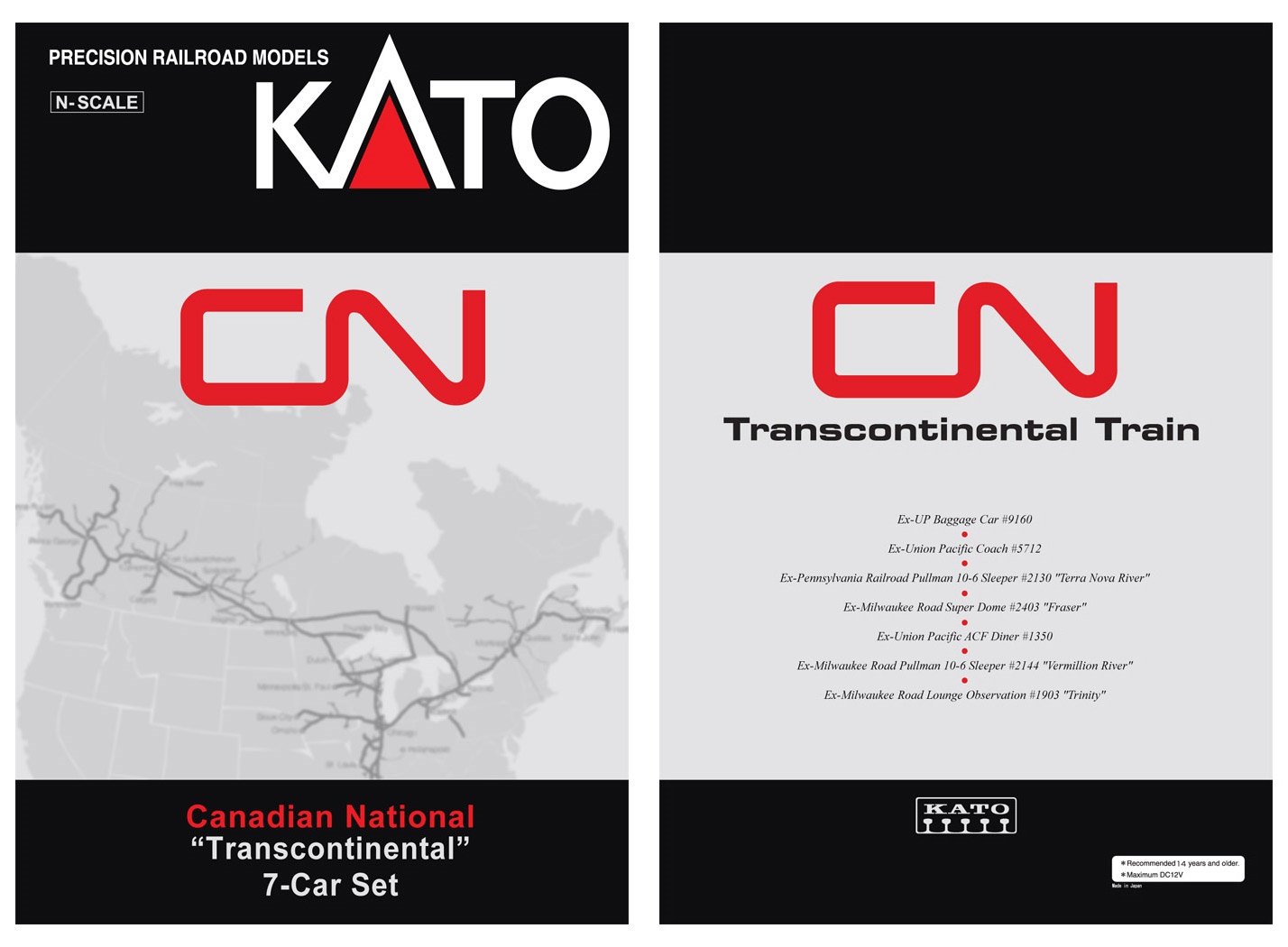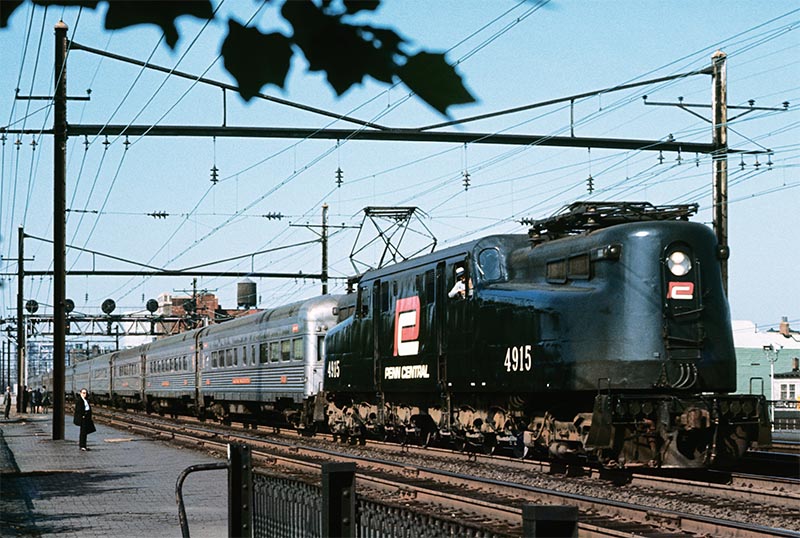Specific Item Information: Canadian National "Transcontinental" 7-Car Set w/ Interior Lighting Installed
Kato is proud to announce a brand new Passenger car set – designed to replicate the continent-spanning trains of the Canadian National during the late 60’s and 70’s, this “Transcontinental” CN 7-Car Train will come packaged in Kato’s bookcase style packaging and will be released alongside a new release of F7A & F7B locomotives in CN’s signature black and white striped paint from the era!
This set uses a variety of ex-Union Pacific, Milwaukee, and Pennsylvania cars which the CN acquired over the years as they built up their passenger service in the pre-VIA Rail day!
Includes:
Kato is proud to announce a brand new Passenger car set – designed to replicate the continent-spanning trains of the Canadian National during the late 60’s and 70’s, this “Transcontinental” CN 7-Car Train will come packaged in Kato’s bookcase style packaging and will be released alongside a new release of F7A & F7B locomotives in CN’s signature black and white striped paint from the era!
This set uses a variety of ex-Union Pacific, Milwaukee, and Pennsylvania cars which the CN acquired over the years as they built up their passenger service in the pre-VIA Rail day!
Includes:
- Ex-Union Pacific Baggage Car #9160
- Ex-Union Pacific Coach #5712
- Ex-Pennsylvania Railroad Pullman 10-6 Sleeper #2130 "Terra Nova River"
- Ex-Milwaukee Road Super Dome #2403 "Fraser"
- Ex-Union Pacific ACF Diner #1350
- Ex-Milwaukee Road Pullman 10-6 Sleeper #2144 "Vermillion River"
- Ex-Milwaukee Road Lounge Observation #1903 "Trinity"
Model Information: Kato boxed sets for North American Prototypes come in various shapes and sizes. These may contain complete train sets with locomotive, track and power pack or may be as simple as a pair of passenger coaches. Many of the sets use "bookshelf" boxes with cardboard sleeves and carefully cut foam inserts.
Prototype History: Due to the advantages of diesel locomotives, railroads in North America had retired 90% of their steam locomotives by the mid-1950. Also, major cities and their rail yards became unhappy neighbors in post-war America. People were no longer content to endure the large amounts of soot and smoke that coal burning steam engines produced. Early diesels, while dirty by today's standards, were a gigantic improvement in air pollution over steam.
Passenger consists were considered the most 'sexy' of any railroads operations, and hence usually got the newest flashiest equipment. A major exception, of course, was Amtrak, which had no competition and a huge inventory of cast-off locomotives and rolling stock acquired during its formation. Hence, rail service in the 1960s and 1970s was a hodgepodge of the newest, best-looking locomotives and railcars as well as a showcase for older makeshift equipment.
Passenger consists were considered the most 'sexy' of any railroads operations, and hence usually got the newest flashiest equipment. A major exception, of course, was Amtrak, which had no competition and a huge inventory of cast-off locomotives and rolling stock acquired during its formation. Hence, rail service in the 1960s and 1970s was a hodgepodge of the newest, best-looking locomotives and railcars as well as a showcase for older makeshift equipment.
Road Name History: The Canadian National Railway Company (reporting mark CN) is a Canadian Class I railway headquartered in Montreal, Quebec that serves Canada and the Midwestern and Southern United States. CN's slogan is "North America's Railroad". CN is a public company with 24,000 employees. It had a market capitalization of 32 billion CAD in 2011. CN was government-owned, having been a Canadian Crown corporation from its founding to its privatization in 1995. Bill Gates was, in 2011, the largest single shareholder of CN stock.
CN is the largest railway in Canada, in terms of both revenue and the physical size of its rail network, and is currently Canada's only transcontinental railway company, spanning Canada from the Atlantic coast in Nova Scotia to the Pacific coast in British Columbia. Its range once reached across the island of Newfoundland until 1988, when the Newfoundland Railway was abandoned.
Following CN's purchase of Illinois Central (IC) and a number of smaller US railways, it also has extensive trackage in the central United States along the Mississippi River valley from the Great Lakes to the Gulf of Mexico. Today, CN owns about 20,400 route miles (32,831 km) of track in 8 provinces (the only two not served by CN are Newfoundland & Labrador and Prince Edward Island), as well as a 70-mile (113 km) stretch of track (see Mackenzie Northern Railway) into the Northwest Territories to Hay River on the southern shore of Great Slave Lake; it is the northernmost rail line anywhere within the North American Rail Network, as far north as Anchorage, Alaska (although the Alaska Railroad goes further north than this, it is isolated from the rest of the rail network).
The railway was referred to as the Canadian National Railways (CNR) between 1918 and 1960, and as Canadian National/Canadien National (CN) from 1960 to the present.
Read more on Wikipedia.
CN is the largest railway in Canada, in terms of both revenue and the physical size of its rail network, and is currently Canada's only transcontinental railway company, spanning Canada from the Atlantic coast in Nova Scotia to the Pacific coast in British Columbia. Its range once reached across the island of Newfoundland until 1988, when the Newfoundland Railway was abandoned.
Following CN's purchase of Illinois Central (IC) and a number of smaller US railways, it also has extensive trackage in the central United States along the Mississippi River valley from the Great Lakes to the Gulf of Mexico. Today, CN owns about 20,400 route miles (32,831 km) of track in 8 provinces (the only two not served by CN are Newfoundland & Labrador and Prince Edward Island), as well as a 70-mile (113 km) stretch of track (see Mackenzie Northern Railway) into the Northwest Territories to Hay River on the southern shore of Great Slave Lake; it is the northernmost rail line anywhere within the North American Rail Network, as far north as Anchorage, Alaska (although the Alaska Railroad goes further north than this, it is isolated from the rest of the rail network).
The railway was referred to as the Canadian National Railways (CNR) between 1918 and 1960, and as Canadian National/Canadien National (CN) from 1960 to the present.
Read more on Wikipedia.
Brand/Importer Information: KATO U.S.A. was established in 1986, with the first U.S. locomotive model (the GP38-2, in N-Scale) released in 1987. Since that time, KATO has come to be known as one of the leading manufacturers of precision railroad products for the modeling community. KATO's parent company, Sekisui Kinzoku Co., Ltd., is headquartered in Tokyo, Japan.
In addition to producing ready-to-run HO and N scale models that are universally hailed for their high level of detail, craftsmanship and operation, KATO also manufactures UNITRACK. UNITRACK is the finest rail & roadbed modular track system available to modelers today. With the track and roadbed integrated into a single piece, UNITRACK features a nickel-silver rail and a realistic-looking roadbed. Patented UNIJOINERS allow sections to be snapped together quickly and securely, time after time if necessary.
The Kato U.S.A. office and warehouse facility is located in Schaumburg, Illinois, approximately 30 miles northwest of Chicago. All research & development of new North American products is performed here, in addition to the sales and distribution of merchandise to a vast network of wholesale representatives and retail dealers. Models requiring service sent in by hobbyists are usually attended to at this location as well. The manufacturing of all KATO products is performed in Japan.
Supporters of KATO should note that there is currently no showroom or operating exhibit of models at the Schaumburg facility. Furthermore, model parts are the only merchandise sold directly to consumers. (Please view the Parts Catalog of this website for more specific information.)
In addition to producing ready-to-run HO and N scale models that are universally hailed for their high level of detail, craftsmanship and operation, KATO also manufactures UNITRACK. UNITRACK is the finest rail & roadbed modular track system available to modelers today. With the track and roadbed integrated into a single piece, UNITRACK features a nickel-silver rail and a realistic-looking roadbed. Patented UNIJOINERS allow sections to be snapped together quickly and securely, time after time if necessary.
The Kato U.S.A. office and warehouse facility is located in Schaumburg, Illinois, approximately 30 miles northwest of Chicago. All research & development of new North American products is performed here, in addition to the sales and distribution of merchandise to a vast network of wholesale representatives and retail dealers. Models requiring service sent in by hobbyists are usually attended to at this location as well. The manufacturing of all KATO products is performed in Japan.
Supporters of KATO should note that there is currently no showroom or operating exhibit of models at the Schaumburg facility. Furthermore, model parts are the only merchandise sold directly to consumers. (Please view the Parts Catalog of this website for more specific information.)
Item created by: CNW400 on 2019-12-13 13:57:09. Last edited by Alain LM on 2023-03-15 10:34:51
If you see errors or missing data in this entry, please feel free to log in and edit it. Anyone with a Gmail account can log in instantly.
If you see errors or missing data in this entry, please feel free to log in and edit it. Anyone with a Gmail account can log in instantly.












